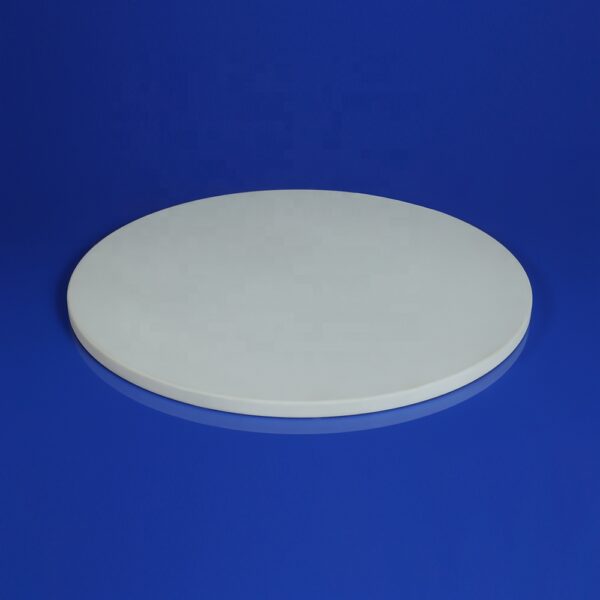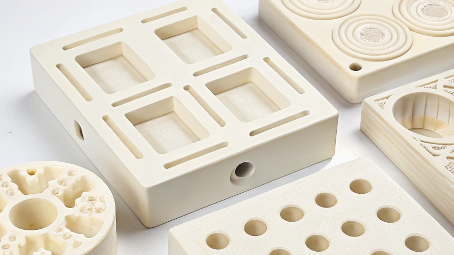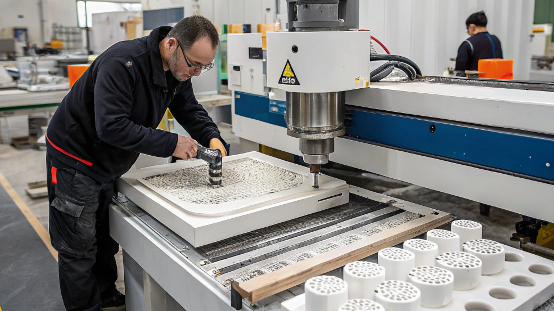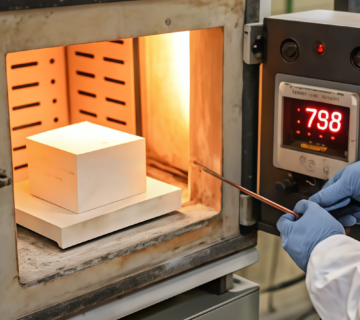What Are the Key Technical Bottlenecks in Alumina Metallized Ceramics?
The question "What are the current technical bottlenecks in the preparation process of alumina metallized ceramics?" highlights the significant challenges faced in creating reliable and high-performance ceramic-metal assemblies. These bottlenecks directly impact the functionality and longevity of components used in various critical applications, hindering innovation and increasing costs. The core issue revolves around achieving a strong, durable, and functional metallic bond to the inherently inert alumina ceramic substrate.
Why Does Poor Adhesion1 Plague Reliability?
Achieving strong and reliable adhesion between the metallic layer and the alumina substrate is a persistent challenge. Inadequate adhesion can lead to delamination under thermal cycling, mechanical stress, or harsh environmental conditions, resulting in device failure and costly replacements. Doesn’t the risk of delamination and failure due to weak adhesion severely limit the reliability of alumina metallized components in critical applications?
Indeed, unreliable adhesion directly translates to increased failure rates, higher maintenance costs, and compromised system performance, especially in demanding environments.
| Bottleneck | Consequence | Impact on Reliability |
|---|---|---|
| Poor Adhesion | Delamination under stress, device failure | Severe |
| Weak Interfacial Bond | Reduced mechanical strength, susceptibility to cracking | Significant |
| Inadequate Wetting | Non-uniform metallization, poor electrical contact | Moderate |
How Does Inconsistency Hinder Performance?
Variations in the metallization process can lead to inconsistencies in the thickness, uniformity, and electrical properties of the metallic layer. This inconsistency can affect the electrical conductivity, bonding strength, and overall performance of the metallized ceramic component, making it difficult to achieve predictable and reliable device operation. Doesn’t inconsistent metallization quality lead to performance variability and hinder the standardization of alumina metallized components?
Absolutely, inconsistent metallization results in unpredictable performance, making it challenging to implement these components in applications requiring tight tolerances and reliable operation.
| Bottleneck | Consequence | Impact on Performance |
|---|---|---|
| Non-uniform Thickness | Variable electrical resistance, uneven stress distribution | Moderate |
| Inconsistent Coverage | Poor electrical or thermal contact, localized failures | Significant |
| Property Variations | Unpredictable device behavior, difficulty in standardization | Severe |
Do Material and Process Limits Constrain Applications?
Current metallization techniques often impose limitations on the types of metals that can be effectively bonded to alumina and may require complex, high-temperature processing in controlled atmospheres. These limitations can restrict the design flexibility and increase manufacturing costs. Doesn’t the restricted choice of metallization materials and complex processing limit the potential applications and increase the cost of alumina metallized ceramics?
Indeed, the limitations in material selection and processing complexity hinder innovation and prevent the widespread adoption of alumina metallized ceramics in various cost-sensitive applications.
Why Is Hermetic Sealing2 So Difficult to Achieve?
For applications requiring hermetic sealing, such as in vacuum electronics or sensor housings, achieving a gas-tight bond between the metal and alumina remains a significant hurdle. Micro-cracks, porosity in the metallization layer, or poor interfacial bonding can compromise the hermeticity, leading to device malfunction or failure in sensitive environments. Doesn’t the difficulty in achieving reliable hermetic seals restrict the use of alumina metallized ceramics in critical vacuum and high-pressure applications?
Precisely, the inability to consistently create hermetic seals limits the applicability of these materials in environments where maintaining a specific atmosphere is crucial.
| Bottleneck | Consequence | Impact on Applications |
|---|---|---|
| Porosity in Metallization | Leakage, loss of vacuum or controlled atmosphere | Severe |
| Micro-cracks at Interface | Path for gas permeation, reduced mechanical strength | Significant |
| Poor Interfacial Sealing | Failure to maintain hermeticity over time | Severe |
Can Surface Activation Improve Wettability?
To address the poor wettability of alumina, we employ advanced surface activation techniques such as plasma treatment or chemical etching. These methods modify the alumina surface, increasing its surface energy and creating micro-scale roughness that promotes mechanical interlocking and enhances the wettability of the molten metal. Can simply roughening the surface guarantee strong adhesion?
While surface roughening improves mechanical interlocking, our controlled surface activation techniques also introduce functional groups that promote chemical bonding with the metallization layer, leading to significantly enhanced adhesion strength.
How Do Optimized Processes Enhance Bonding?
We utilize advanced metallization techniques such as active metal brazing (AMB) and direct copper bonding (DCB) with optimized alloy compositions. AMB employs brazing alloys containing reactive elements like titanium or zirconium, which chemically react with the alumina to form strong interfacial bonds. DCB, particularly for copper metallization, involves a high-temperature bonding process under a controlled atmosphere, resulting in a direct and robust copper-alumina bond. Are these advanced bonding techniques suitable for mass production?
Yes, while requiring precise process control, AMB and DCB are established industrial processes that can be scaled for high-volume manufacturing with consistent quality.
| Feature | Moly-Manganese (Mo-Mn) | Active Metal Brazing (AMB) | Direct Copper Bonding (DCB) |
|---|---|---|---|
| Bonding Temperature (°C) | 1400-1600 | 800-1000 | 1060-1080 |
| Atmosphere | Reducing/Inert | Vacuum/Inert | Inert/Reducing |
| Adhesion Strength | Low to Medium | High | High |
To mitigate the challenges posed by CTE mismatches, we employ interface engineering strategies. This includes the use of interlayers with intermediate CTE values or the creation of graded interfaces that gradually transition between the ceramic and the metal. These techniques help to distribute thermal stresses more evenly, reducing stress concentrations at the interface and enhancing the reliability of the assembly under thermal cycling. Can introducing an interlayer truly alleviate the stress caused by CTE mismatch?
Yes, carefully selected interlayers with tailored CTE and mechanical properties can effectively absorb and redistribute the stresses arising from thermal expansion differences, significantly improving the thermal cycling performance.
Considering the demanding performance requirements of modern electronic devices, power modules, and high-reliability systems, the limitations imposed by traditional alumina metallization techniques become increasingly apparent. Overcoming these technical bottlenecks through advanced surface engineering and optimized metallization processes is crucial for unlocking the full potential of alumina ceramics in a wider range of critical applications.
What Governs Wettability on Alumina?
Achieving good wetting of the molten metal on the alumina surface is the first critical step in forming a strong metallurgical bond. Wettability is governed by the surface energies of the solid (alumina), liquid (molten metal), and the solid-liquid interface. Thermodynamic principles dictate the equilibrium contact angle, while kinetic factors influence the rate at which wetting occurs. Our surface activation techniques aim to lower the contact angle and enhance the spreading kinetics by modifying the alumina surface energy and removing contaminants that hinder wetting. Doesn’t a high contact angle inherently lead to weak bonding and poor coverage?
Yes, poor wetting results in a large contact angle, indicating a non-favorable interaction between the liquid metal and the solid ceramic, leading to weak adhesion and potential voids in the metallization layer.
| Factor | Description | Impact on Wettability |
|---|---|---|
| Surface Energy (Solid) | Energy required to create a unit area of the alumina surface. Higher is better. | Positive |
| Surface Energy (Liquid) | Energy required to create a unit area of the molten metal surface. Lower is better. | Positive |
| Interfacial Energy | Energy at the alumina-metal interface. Lower is better. | Positive |
| Contact Angle | Angle formed at the solid-liquid-gas interface. Lower (closer to 0°) is better. | Negative |
| Surface Cleanliness | Absence of contaminants (e.g., organic residues, oxides) on alumina. | Positive |
How Do Interfacial Reactions Drive Bonding in AMB?
Active metal brazing relies on the chemical reaction between the active elements in the brazing alloy (e.g., Ti, Zr) and the alumina ceramic to form a strong interfacial bond. The reaction typically involves the formation of oxide or aluminate phases at the interface. Understanding the thermodynamics and kinetics of these interfacial reactions3 is crucial for optimizing the brazing process and controlling the thickness and composition of the reaction layer to ensure strong and reliable bonding without forming brittle intermetallic compounds. Isn’t precise control over the interfacial reaction layer essential for achieving optimal bond strength and preventing embrittlement?
Indeed, an excessively thick or brittle reaction layer can compromise the mechanical integrity of the joint, while an insufficient reaction may result in weak adhesion.
Can Stress Distribution Be Engineered at Interfaces?
The mismatch in the coefficient of thermal expansion (CTE) between alumina and most metals inevitably leads to residual stresses at the interface during the cooling process after metallization. Finite element analysis (FEA) and other stress analysis techniques are crucial for understanding the distribution and magnitude of these stresses. By optimizing the geometry of the joint, selecting appropriate interlayer materials, or employing graded interfaces, we can minimize stress concentrations and enhance the reliability of the metallized ceramic under thermal cycling conditions. Doesn’t a high concentration of residual stress significantly increase the risk of cracking and delamination?
Yes, localized high stresses at the interface can act as crack initiation sites, leading to failure of the ceramic or detachment of the metallic layer, especially under thermal stress.
| Stress Mitigation Strategy | Mechanism | Impact on Stress Distribution | Considerations |
|---|---|---|---|
| CTE Matching Interlayers | Interlayer with CTE between ceramic and metal | Even stress distribution | Material selection, bonding with both materials |
| Graded Interfaces | Gradual change in composition and CTE across interface | Reduced stress concentration | Manufacturing complexity |
| Compliant Layers | Soft metal or polymer layer to absorb strain | Lower overall stress | Long-term stability, electrical conductivity |
| Optimized Joint Design | Minimizing sharp corners and stress concentrators | Reduced peak stresses | Design constraints |
How Does Better Metallization Enhance Power Electronics?
In high-power electronic modules, efficient heat dissipation and reliable electrical connections are critical. Advanced alumina metallization techniques like DCB enable direct bonding of thick copper layers to alumina substrates, providing excellent thermal conductivity and high current-carrying capacity. The enhanced adhesion and reliability ensure long-term performance under demanding operating conditions. Wouldn’t improved thermal management and electrical performance significantly enhance the efficiency and lifespan of power electronic devices?
Indeed, the superior thermal and electrical properties achieved through advanced metallization are crucial for the development of more efficient and reliable power electronic systems.

Why Is Robust Metallization Crucial for Automotive Applications?
Automotive electronics and sensors often operate in harsh environments with significant temperature fluctuations and mechanical vibrations. Alumina metallized with robust and reliable bonding techniques can withstand these demanding conditions, ensuring the long-term performance and reliability of critical automotive components. Isn’t the high reliability of metallized alumina essential for the safety and performance of automotive electronic systems?
Absolutely, the durability and stability of metallized alumina are crucial for ensuring the reliable operation of electronic control units and sensors in automobiles.
| Automotive Requirement | Importance for Metallized Alumina | Metallization Technique Examples |
|---|---|---|
| Thermal Cycling Resistance | Withstand frequent temperature changes | CTE matching interlayers, AMB |
| Vibration Resistance | Maintain electrical and mechanical integrity | Strong adhesion via AMB, DCB |
| Humidity Resistance | Prevent corrosion and degradation | Protective overcoats |
| Mechanical Shock | Survive sudden impacts | Robust interfacial bonding |
How Does Reliable Sealing Enable Vacuum Devices?
Vacuum electronic devices, such as microwave tubes and X-ray tubes, require hermetic seals to maintain a high vacuum. Advanced metallization techniques that ensure a gas-tight bond between the metal and alumina are essential for the functionality and longevity of these devices. Isn’t the achievement of a reliable hermetic seal paramount for the operation of vacuum electronic devices?
Yes, maintaining a high vacuum is fundamental to the operation of these devices, and a robust hermetic seal provided by advanced metallization is critical.
Can Advanced Metallization Improve LED Performance?
Efficient heat dissipation is crucial for the performance and lifespan of high-power LEDs. Alumina substrates with highly conductive metallization layers can effectively dissipate heat away from the LED chip, improving efficiency and extending the operating life. Advanced bonding techniques ensure good thermal contact and long-term reliability. Wouldn’t improved thermal management through advanced metallization significantly enhance the performance and lifespan of LED lighting systems?
Indeed, effective heat dissipation enabled by robust metallization is key to achieving high efficiency and long lifespan in LED lighting applications.
Will Novel Materials Revolutionize Bonding?
Ongoing research is focused on developing novel metallization materials and alloys with tailored properties, such as CTE closer to alumina, enhanced oxidation resistance, and improved bonding characteristics. Nanomaterials and composite metallization layers are also being explored to further enhance performance and reliability. Wouldn’t the development of more compatible metallization materials significantly simplify the bonding process and improve long-term reliability?
Yes, the development of materials with closer thermophysical properties to alumina would greatly reduce residual stresses and enhance the overall performance of metallized ceramics.
Can Advanced Characterization Optimize Processes?
Advanced surface characterization techniques, such as X-ray photoelectron spectroscopy (XPS) and atomic force microscopy (AFM), are increasingly being used to gain a deeper understanding of the alumina surface and the ceramic-metal interface. This knowledge is crucial for optimizing surface pre-treatment processes and controlling interfacial reactions to achieve superior bonding. Doesn’t a better understanding of the interface at the atomic level lead to more precise control over the metallization process?
Indeed, advanced characterization techniques provide valuable insights into the interfacial phenomena, enabling the development of more effective and reliable metallization strategies.
| LED Performance Metric | Benefit of Advanced Metallization | Metallization Material Examples |
|---|---|---|
| Light Output | Lower junction temperature | High thermal conductivity metals (Cu) |
| Efficiency | Reduced power loss due to heat | Uniform, low-resistance metallization |
| Lifespan | Lower operating temperature | Strong, reliable bonding |
| Color Stability | More consistent chip temperature | Uniform heat dissipation |
Will Lower Temperatures Expand Application Spaces?
High-temperature metallization processes can be energy-intensive and may limit the integration of metallized alumina with other temperature-sensitive components. Research efforts are directed towards developing low-temperature metallization techniques4, such as ultrasonic bonding or laser-assisted bonding, to reduce processing costs and expand application possibilities. Wouldn’t the development of low-temperature metallization techniques broaden the applicability of alumina metallized ceramics?
Yes, lower processing temperatures would reduce energy consumption, minimize thermal stress on the materials, and enable the integration of metallized alumina with a wider range of substrates and components.
Conclusion
The technical bottlenecks in alumina metallization, primarily concerning adhesion, reliability, material compatibility, and processing complexity, present significant challenges for various industries. Our approach, focusing on advanced surface engineering and optimized metallization technologies, offers a pathway to overcome these limitations and achieve high-performance alumina metallized ceramics. By addressing the fundamental issues at the ceramic-metal interface, we can unlock the full potential of these materials for demanding applications in power electronics, automotive systems, vacuum technology, and thermal management. Continued innovation in materials science and processing techniques will be crucial for further advancing the field of alumina metallization.
-
Understanding the effects of poor adhesion can help in developing better bonding techniques, enhancing reliability in critical applications. ↩
-
Learning about hermetic sealing challenges can inform better design choices and improve the performance of sensitive applications. ↩
-
Understanding interfacial reactions is key to optimizing bonding processes in materials science, ensuring strong and reliable joints. ↩
-
Investigating low-temperature techniques can lead to cost-effective solutions and broaden the application of metallized ceramics in various industries. ↩








No comment